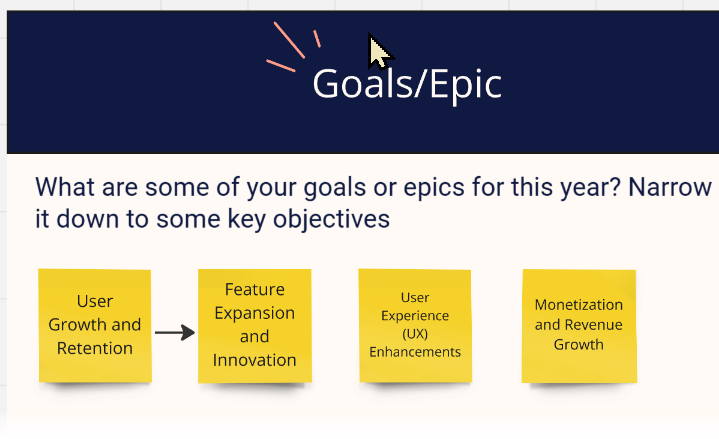Product roadmapping with GitHub
What is a product roadmap?
A product roadmap is a visual representation of a product's journey over time. It helps align teams, prioritize features, and ensure that development efforts are focused on the most impactful goals
Connect GitHub and Miro effortlessly. Import or create Github issues, or turn Miro stickies into GitHub tasks for smoother, smarter collaboration!
Overview
You can use this template to turn your sticky notes into actionable roadmap tasks in a few simple steps: convert notes to cards, sync details with GitHub, and align your team on future plans, backlogs, and sprints.
Plan your roadmap
Turn your sticky notes into cards and start planning what your future roadmap will look like
Add any additional information required in the description
Create actionable items
Make this even faster by using the GitHub for Miro app
Instantly convert your sticky notes to app cards
Update description, milestones and other fields to have it sync with GitHub
Keep your engineers, product managers, and stakeholders on the same page
Get aligned
This is just the start!
Now that you have your roadmap, work with your teams to plan the backlog, future work, and sprint plan.
Check out our Backlog planning template and Sprint planning template.
Who should be involved?
Roadmap planning is typically done by a team of product managers, product owners, and stakeholders rather than a single person. This ensures that all relevant perspectives are considered and that the plan is aligned with the overall product vision and strategy.
Product managers
Responsible for defining the product vision, strategy, and roadmap.
Product owners
Manage the product backlog, prioritize features, and ensure alignment with the product vision.
Executives/stakeholders
A product roadmap is an excellent place for executives and stakeholders to get a high-level overview of timelines & prioritizations.
Why use this template?
Through collaborative roadmap planning, your team should align on the product vision and priorities and tailor the roadmap to meet strategic goals accordingly.
Alignment on Product Vision:
Roadmap planning helps ensure that all team members and stakeholders are aligned on the product vision, providing a unified direction for future development.
Effective Prioritization:
By turning ideas into actionable cards and prioritizing features, your team can focus on the most impactful tasks that align with strategic goals.
Seamless Integration with GitHub:
Utilizing the GitHub for Miro app allows for real-time synchronization of tasks, keeping engineers, product managers, and stakeholders on the same page without duplicating efforts.
Strategic Planning for Future Work:
With a clear roadmap in place, your team can efficiently plan the backlog, future work, and sprints, ensuring that all upcoming tasks are in line with the overall product strategy.
Step 1: Determine key goals
What are some of your goals or epics for this year? Narrow it down to some key objectives. You can see an example at the diagram below:

Step 2: Determine some objective breakdowns
You can achieve the goal of increasing active user engagement and retention rates by breaking down your goals into actionable tasks. Here, we show you how to create objectives for the first goal of user growth and retention. In the example below, we connect to a GitHub repository and create issues of the 5 planned objectives. You can also see how interaction can be done at GitHub using comments.
Step 3: Product roadmap planning
Start by transforming your sticky notes into individual cards, organizing them as actionable items in your roadmap. Add relevant details for each card in the description to ensure everyone understands the context and requirements.
Once the cards are set up, begin adding them to the roadmap table on Miro, aligning each one within the quarterly timeline. This visual arrangement helps outline priorities and ensures a clear view of what’s planned for each quarter. As you populate the roadmap, categorize each card based on the type of task (e.g., feature development, UX improvements, bug fixes) and specify dependencies or blockers where applicable.
By structuring the roadmap this way, you'll create a cohesive plan that keeps the team aligned and focused on quarterly goals. Here’s an example of how the team has planned to complete the key objectives shown previously.

